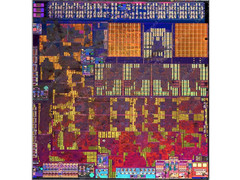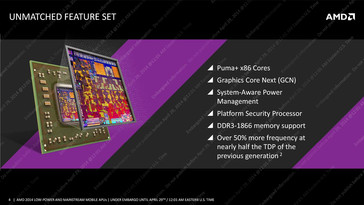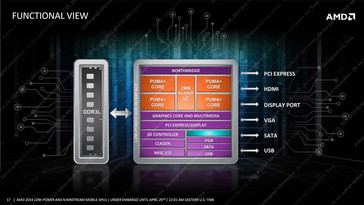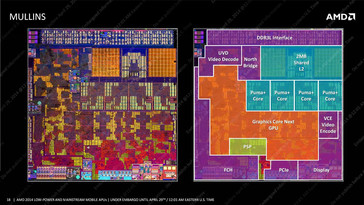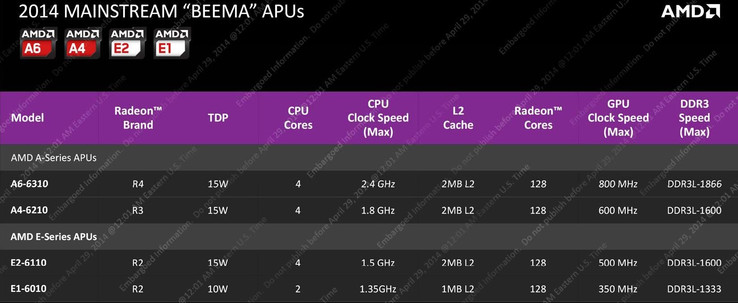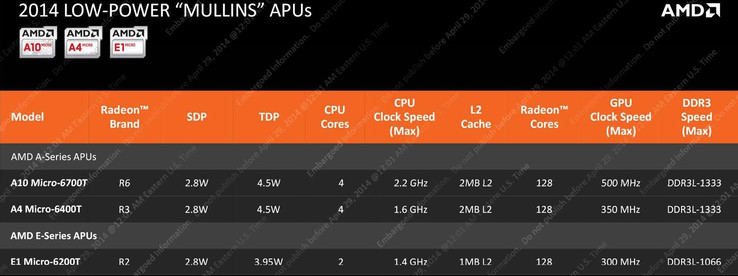Regardless of Intel's dominance in many parts of the CPU market, AMD have been able to stand up to the big competitor in at least one segment: the APUs of the Brazos generation. The chips simply delivered more performance and superior multimedia capabilities compared to the Atom platform of the time.
In the last year, Brazos has been replaced by Kabini (Notebooks) and Temash (Tablets), which are the first fully integrated SoCs to include the Southbridge. Performance increased significantly, too, thanks to an improved CPU architecture, up to 4 cores and the modern GCN graphics unit. However, Intel counterattacked just a few month later with the completely revamped Bay Trail family. While it did not achieve the same performance levels, it scored points with a notably lower power consumption.
As a result, AMD was forced to improve and put more attention to power consumption. Beema and Mullins, both based on the same 28 nm die, are to be seen as an evolution of Kabini and Temash. Thanks to a number of improvements, they should deliver up to twice the performance per Watt. The former Jaguar cores were optimized for the lowest possible leakage and are now called "Puma+".
AMD uses an intelligent Boost mode, which allows for significantly higher clock rates than before for limited periods of time in order to simultaneously increase performance – according to the manufacturer the IPC (performance per clock) remains the same. The goal is to compensate for short-time peak loads, improve the responsiveness of the system and to allow for a faster return to idle mode ("Race to idle"). The predecessor, which normally did not feature a CPU Turbo at all, showed several weaknesses here. Further efficiency gains were made possible by an optimized display interface and a new memory controller, which optionally allows higher frequencies (up to DDR3(L)-1866) or an even lower power consumption (low-power DDR3(L)-1333 mode).
Let's take a closer look at the new APUs and start with the notebook-based APU Beema. Although the TDP was decreased from the former maximum of 25 Watt (A6-5200) to only 15 Watt, the Boost clock rate of the A6-6310 top model has increased to an impressive 2.4 GHz. Please note that AMD does not specify a base frequency. So, this clock rate will likely not be consistently available. The same is also true for the smaller A4-6210 (max. 1.8 GHz), AMD E-Series E2-6110 Notebook ProcessorE2-6110 (max. 1.5 GHz), and E1-6010 (max. 1.35 GHz, Dual-Core) models. The clock rate of the 128 shader units (unchanged) is now up to 800 MHz depending on the model.
The improvements of the Mullins APU designed for fanless tablets should be even bigger. It has a specified TDP of only 3.95 to 4.5 Watt (SDP 2.8 Watt), while Temash featured a TDP of up to 8 Watt (A6-1450). The clock rate also received a boost: The fastest model, the A10 Micro-6700T reaches 2.2 GHz, while the A4 Micro-6400T maxes out at 1.6 GHz and the dual-core E1 Micro-6200T to 1.4 GHz. Compared to Beema, Mullins features a slightly reduced GPU and memory clock in order to meet the extremely low power consumption envelope.
Apart from performance and efficiency gains, which remain to be verified in practice, the APUs also bring several new features. It is the first time that AMD is integrating an additional ARM core to allow for a number of different hardware-based security features. In addition, 4K videos can be decoded and displayed at up to 30 fps and the VCE encoder has been optimized for wireless display with especially low latencies.
AMD only vaguely answered our questions about the availability of the initial wave of new APUs. They should be ready in the coming one to three months. So far, they have Lenovo as a key partner. AMD should not wait too long with the launch of the new APUs as Intel will be introducing its Bay Trail successor called Cherry Trail towards the end of the year, which will be the first mass-produced consumer product using 14 nm lithography.
Source(s)
Own


